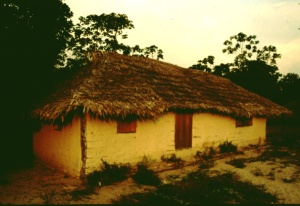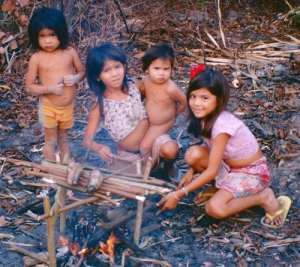
Plowden family house in Tekohaw 1997-1999. ©Photo by Campbell Plowden/Center for Amazon Community Ecology
Beginning in the fall of 1997, my wife, 7 year old daughter, 2 year old son, and I lived for a year with the Tembé Indians in the eastern Brazilian Amazon while I did field work for my PhD in Ecology. Our home in the village of Tekohaw was a three room mud wall house with a palm thatch roof. We slept side-by-side in hammocks, used an outhouse in the back yard, cooked over a two-burner gas stove, bathed in the Gurupi River, and traded surplus packaged food from the city for fresh fish, fruit and game meat brought to us by our neighbors.

Marissa Plowden with Emidio Tembé kids cooking fish. © Photo by Campbell Plowden/Center for Amazon Community Ecology
The simple living was a good challenge for our family used to basic American comforts, but after three months of washing clothes by hand, hearing everyone speak a strange language, and pleading for field assistants to start the research, Yuri, Marissa and I were all ready for a Thanksgiving break in the city. Young Luke was happy as long as Mom was nearby.

Emidio Tembé with white crested guan. © Photo by Campbell Plowden/Center for Amazon Community Ecology
Since we were going to have a big dinner with some fellow researchers, I thought it would be appropriate to bring along a bird from our Tembé hosts. Our friend Emidio kindly complied with my request and killed a “jacu” (white crested guan) for us to bring to the city. My Brazilian colleagues appreciated my story about the origin of Thanksgiving and our bird from the Tembé hunter, but I have to admit that the freshly cooked turkey and apple pie tasted a lot better than the funky “jacu” hadn’t made the long journey from the forest in prime condition in spite of being smoked.
A year later, my family was back in Pennsylvania while I prepared to spend Thanksgiving in Tekohaw. My research was really in full swing by then so I decided to use the occasion to thank my Tembé research colleagues and a few close neighbors with the best dinner I could put together with my limited supply of prime fare. My first sign of warning should have been the tingling of my instinct when I invited the guests out of earshot of others. Having discreetly made the invitations, I returned to the house and started cooking and preparing the house.

Maku Ka’apor and child in Tekohaw. © Photo by Campbell Plowden/Center for Amazon Community Ecology
While setting the biggest table with a tablecloth (a dirty sheet) and candles, I heard someone come in the house. Maku, a deaf mute Ka’apor indian who seemed to have ESP regarding unusual events in my house, walked in, took one look at the spread and walked out without making any attempt to communicate with me.

Campbell Plowden with Tembé men in the forest. © Photo by Campbell Plowden/Center for Amazon Community Ecology
Eventually the invited guests and a few other uninvited ones came in and took a seat at the table or bench on the periphery. I gave my spiel about how special it was to be celebrating Thanksgiving with them since most Americans have long ago forgotten about the Native American connection to the holiday and served the meal. While the guests clearly enjoyed the food, they spoke little, thanked me and left shortly after all plates were empty. I didn’t know what he was really thinking, but I wondered if Lourival, the village headman, felt particularly awkward being at a gathering to which all had not been invited. To say the least, the evening did not resemble my fantasy of recreating the jovial atmosphere of Thanksgiving dinners at home.

Lourdinha Tembé and Luke Plowden with bow drill. © Photo by Campbell Plowden/Center for Amazon Community Ecology
Several weeks later I was due to celebrate my 45th birthday. Intent on not repeating the Thanksgiving experience, I enlisted the help of my friend Lourdinha to do a Tembé style celebration. I didn’t have much food left on my shelf, but I gave her almost all that I had left to prepare for the feast. I went around to all 25 houses in the village and invited one and all to the village meeting house.

Veronica Tembé painting Campbell Plowden at traditional festival. © Photo by Bruce Hoeft/Center for Amazon Community Ecology
At the appointed hour, the open-air structure was full of folks from the village and many visitors who had arrived to help celebrate a one-day festival in honor of Saint Luzia. The headwoman Veronica ladled out the offerings of watery oatmeal, coffee and hot chocolate one third of a cup at a time to a throng of kids jostling in front of the serving table illuminated only by two small kerosene lanterns. Within half an hour, the oatmeal, beverages and three cans of goiabada (guava jelly) were gone. While I wished I’d had twice as much food to serve, I believe everyone had a good time.

Moreira Tembé chanting at traditional festival. © Photo by Campbell Center for Amazon Community Ecology
My wonderful present was sharing a little of my bounty with a hundred fine folks and joining in on the chorus of a traditional Tembe chant being vigorously belted out by two men. The next day I did share a small cake in the forest with my research crew who sang me a Brazilian rendition of Happy Birthday.












